|
Centrip Editorial Board
Tour 13 Famous Castles around Central Japan from Nagoya

The Central Japan region centered on Nagoya was the birthplace of the three great military commanders who contributed to ending the Warring States period and unifying the country: Nobunaga Oda, Hideyoshi Toyotomi, and Ieyasu Tokugawa. In addition to being home to three of Japan's five national treasures, the Central Japan region has countless unique castles with engaging stories.
Read on for 13 famous castles in Central Japan that are perfect for fans of Japanese samurai culture and castle architecture and show you how to visit them.
Table of Contents
- Nagoya and Surrounding Areas
- • Nagoya Castle (Nagoya City, Aichi Prefecture)
- • The National Treasure Inuyama Castle (Inuyama City, Aichi Prefecture)
- • Gifu Castle (Gifu City, Gifu Prefecture)
- North of Gifu
- • Gujo Hachiman Castle (Gujo City, Gifu Prefecture)
- • Echizen Ono Castle (Ono City, Fukui Prefecture)
- From Nagoya to Matsumoto along the Nakasendo Road
- • Iwamura Castle (Ena City, Gifu Prefecture)
- • Naegi Castle (Nakatsugawa City, Gifu Prefecture)
- • The National Treasure Matsumoto Castle (Matsumoto City, Nagano Prefecture)
- From Nagoya to the west
- • Iga Ueno Castle (Iga City, Mie Prefecture)
- • The National Treasure Hikone Castle (Matsumoto City, Nagano Pref.)
- From Nagoya to the east
- • Okazaki Castle (Okazaki City, Aichi Prefecture)
- • Hamamatsu Castle (Hamamatsu City, Shizuoka Prefecture)
- • Sunpu Castle (Shizuoka City, Shizuoka Prefecture)
Nagoya and its vicinity
Nagoya Castle (Nagoya City, Aichi Prefecture)
First up is Nagoya Castle. Constructed about 500 years ago, it has remained the center of Nagoya ever since. The giant golden Shachihoko placed at the top of the Nagoya Castle are symbols of Nagoya. The castle is easily reached from Nagoya Station, only 15 minutes away (the nearest station is Nagoya Castle Station on the subway line).
 Nagoya Castle, famous for its cherry blossoms in spring
Nagoya Castle, famous for its cherry blossoms in spring
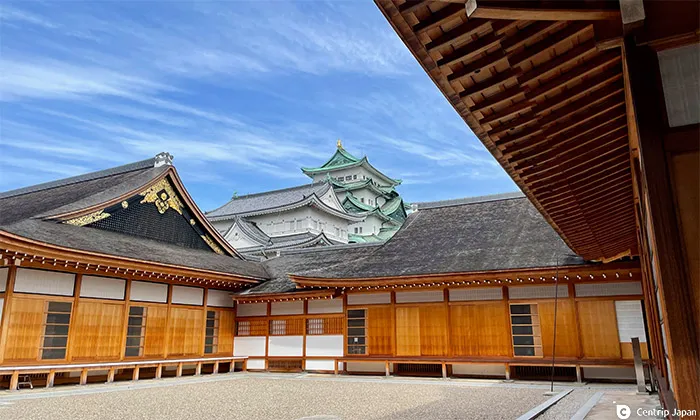 Nagoya Castle seen from Honmaru Goten
Nagoya Castle seen from Honmaru Goten
Nagoya Castle is one of three of the most famous castles in Japan, along with Osaka Castle and Kumamoto Castle. In recent years, the Honmaru Goten, the former residence of the feudal lord, was extensively restored, adding to the castle's attractions. The ornate decoration of the Omote-shoin (a room where the feudal lord met with guests) is a sight to behold.
Inside the castle, visitors can meet actors dressed as famous military commanders and the ninja historically associated with Nagoya Castle, such as Nobunaga Oda and Hanzo Hattori. Not only are they authentically dressed they act their roles as well. They are also happy to pose for souvenir photos with you.
Related articles
The National Treasure Inuyama Castle (Inuyama City, Aichi Prefecture)
Next, let's head for Inuyama Station, located a short distance north of Nagoya, about 30 minutes from Nagoya Station on the Meitetsu Inuyama Line. Get off at Inuyama Station and walk through the bustling Honmachi-dori Street to reach the national treasure known as Inuyama Castle.
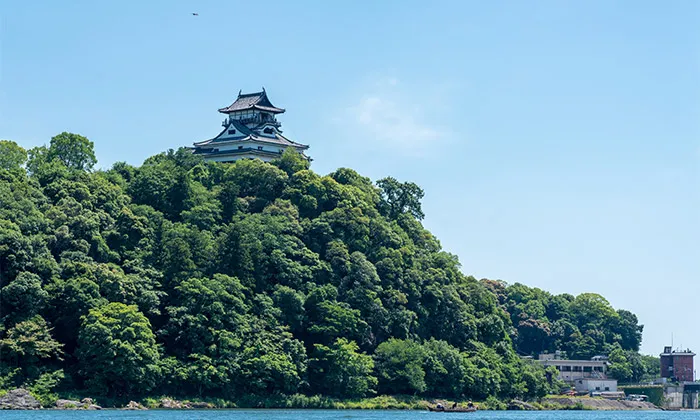 Inuyama Castle seen from the Kiso River
Inuyama Castle seen from the Kiso River
 View from the castle tower
View from the castle tower
Inuyama Castle was built in 1537, and its keep is considered the oldest of its kind in Japan. Built on top of a small mountain by the Kiso River, the view from the castle tower is truly spectacular. If you are afraid of heights, watch your step!
 A view of the castle town
A view of the castle town
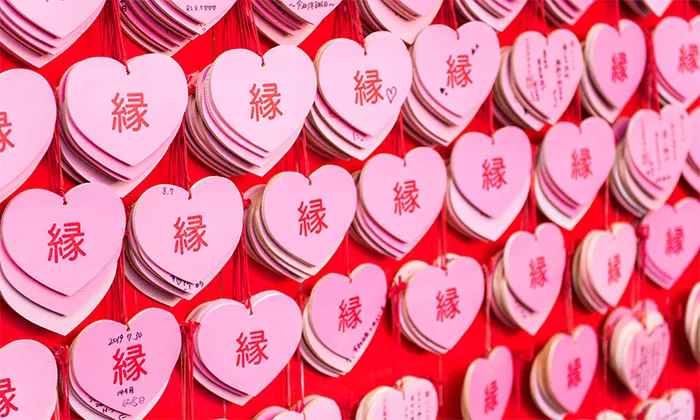 Heart Scroll at Sanko Inari Shrine
Heart Scroll at Sanko Inari Shrine
The bustling castle town is one of the busiest in the Chubu area. The town is lined with restaurants and sweet stores that are perfect for Instagram. Visitors can also experience rickshaw rides and kimono dressing. At Sanko Inari Shrine, located at the foot of Inuyama Castle, visitors can write their wishes on a cute pink heart-shaped ema (votive tablet).
Gifu Castle (Gifu City, Gifu Prefecture)
To get to Gifu Castle, take the JR Tokaido Line or Meitetsu Line from Nagoya Station to Gifu Station (about 30 minutes), and then take a bus or cab to the castle (about 10 minutes).
Gifu Castle is an impregnable castle built on Mount Kinka, 329 meters above sea level. It was the base for the unification of Japan by Oda Nobunaga. Looking up at the castle tower rising from the foot of the mountain, it looks impregnable. The steep mountain path to the castle tower, on which Nobunaga may have once walked, can be climbed in about one to two hours, and if you are confident in your strength, please try it. Alternatively, you can take the ropeway to the top, which takes about 4 minutes. The view from the castle tower in the middle of the Nobi Plain is breathtaking, and the sunset is beautiful.
 Gifu Castle comes into view as you ascend Mt. Kinka
Gifu Castle comes into view as you ascend Mt. Kinka
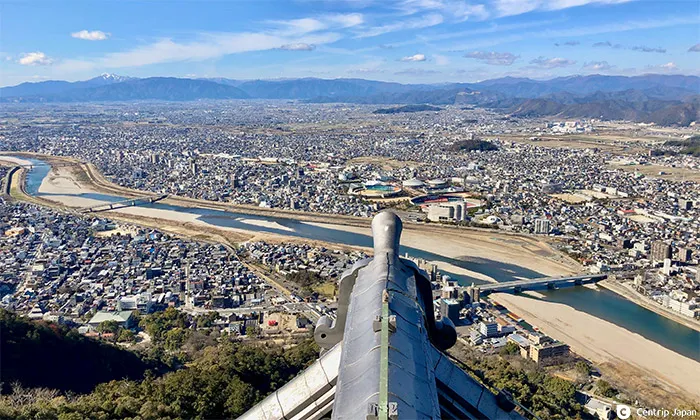 View from the keep
View from the keep
Tickets are also available for 5,000 yen per adult to tour Nagoya Castle, Inuyama Castle, and Gifu Castle with various benefits (Meitetsu Castle Tour Ticket 2-DAY Round Trip Course).
Related articles
North of Gifu
Gujo Hachiman Castle (Gujo City, Gifu Prefecture)
Go north of Gifu Station for an hour by bus or rental car. This area is high in elevation and has many famous mountain castles that take advantage of the mountainous terrain. Among them is Gujo Hachiman Castle. It is called "the most beautiful mountain castle in Japan" by the famous Japanese novelist Ryotaro Shiba and is worth visiting at least once. It changes appearance depending on the season you visit, such as in autumn when the mountains turn red with autumn leaves and in winter, white and covered with snow.
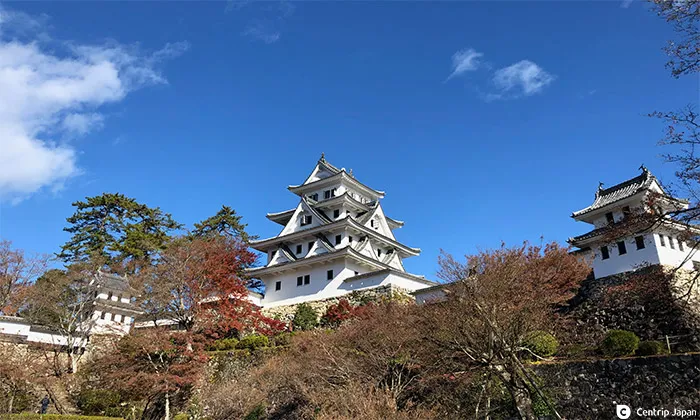 Beautiful chalk-white Gujo Hachiman Castle
Beautiful chalk-white Gujo Hachiman Castle
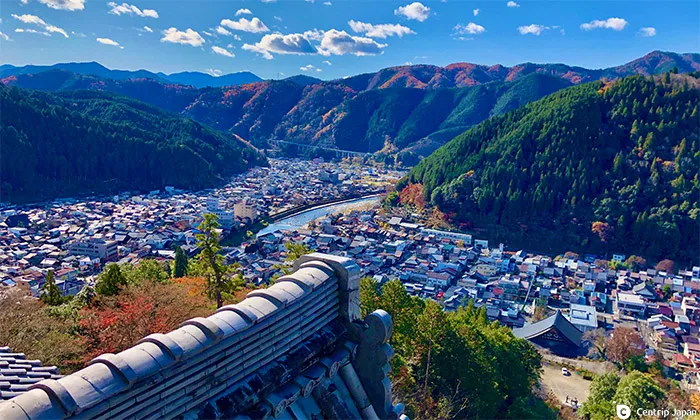 View from the castle keep
View from the castle keep
The castle town that spreads out under the castle is also known for its beautiful spring water and delicious food, such as soba noodles made using the famous water. In summer, an all-night dance festival called Gujo Odori is held in the town. Many traditional handicrafts, such as honzome (dyed goods) associated with the Gujo Odori dance, are available as souvenirs.
Echizen Ono Castle (Ono City, Fukui Prefecture)
If you like driving, you may want to go further north of Gujo Hachiman. If you continue on a stretch of the former Mino Kaido Road (now Route 158) while gazing at beautiful Lake Kuzuryu, you will eventually reach the town of Echizen-Ono.
 The Castle in the Sky
The Castle in the Sky
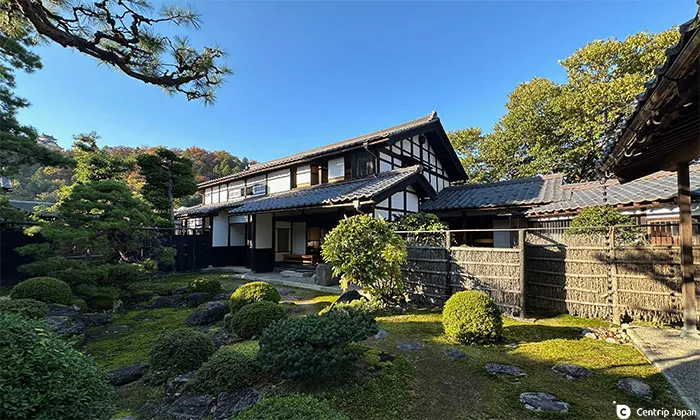 Former Uchiyama family residence
Former Uchiyama family residence
Echizen-Ono Castle stands in the center of Echizen-Ono and is known as The Castle in the Sky. From late fall through spring, when weather conditions are favorable, the castle floats above a sea of clouds, creating a fantastic sight. In the castle town, visitors can tour samurai residences such as the Former Uchiyama Family and Former Tamura Family residences, and enjoy sake and soy sauce breweries that originated in the old castle town, where visitors can sample sake and try their hand at making soy sauce.
Related articles
From Nagoya to Matsumoto along the Nakasendo Road
Iwamura Castle (Ena City, Gifu Prefecture)
Magomejuku is the gateway to the Nakasendo Kiso Road, popularly known as the Samurai Trail, and to reach it from Nagoya, take the JR Chuo Line from Nagoya Station to Nakatsugawa Station, then take a bus or cab. If your goal is to visit a castle, get off at Ena Station, two stops before Nakatsugawa Station, and take a quaint local train on the Aketetsu Railroad to Iwamura Castle.
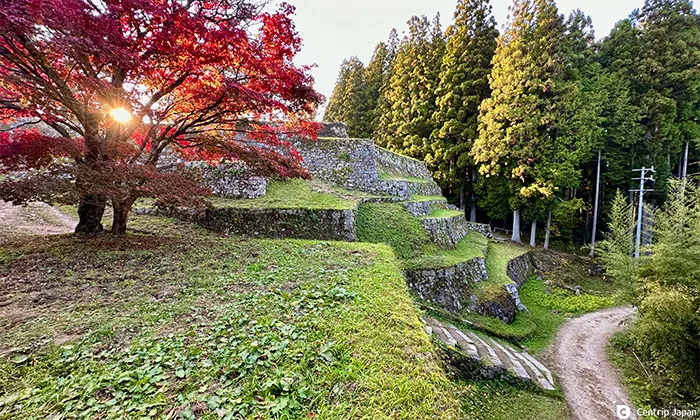 Iwamura Castle still retains its magnificent stonewalls
Iwamura Castle still retains its magnificent stonewalls
 Iwamura Historical Museum located at the foot of the castle
Iwamura Historical Museum located at the foot of the castle
Iwamura Castle is said to have been ruled by a woman named Otsuya, an aunt of Nobunaga Oda. She ruled the castle during the Warring States Period (there are a few cases in Japanese history where a woman was lord of a castle). Although only the remains of the stonewalls remain today, the huge stonewalls built on the top of the mountain are well worth a visit.
Naegi Castle (Nakatsugawa City, Gifu Prefecture)
Naegi Castle is only 10 km in a straight line from Iwamura Castle. All that remains of Naegi Castle is a ruin built on a large natural rock, with an observation deck built recently using the post holes of the former castle tower. The scenery of the giant rocks and stone walls has become popular on social networking sites because of its resemblance to Machu Picchu, a World Heritage site.
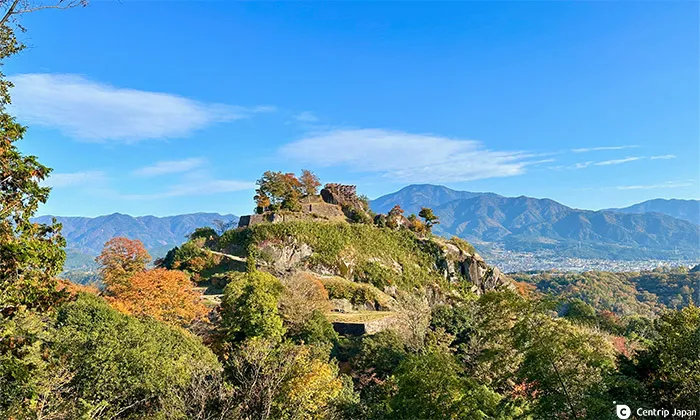 The stone wall, rising above the rocks, gives the appearance of Machu Picchu
The stone wall, rising above the rocks, gives the appearance of Machu Picchu
 Beautiful sunsets can be seen from the keep's observation deck
Beautiful sunsets can be seen from the keep's observation deck
Iwamura Castle and Naegi Castle are close to Magomejuku, a former post town on the old Nakasendo Highway. They are also great places to visit when touring around the post towns or walking along the Nakasendo Highway.
The National Treasure Matsumoto Castle
Take the limited express Shinano from Nakatsugawa Station to Matsumoto Station, where the national treasure Matsumoto Castle is located, in about 1 hour and 15 minutes (about 2 hours if you go directly from Nagoya Station).
The symbol of Japanese castles is the castle keep, and only 12 castles in Japan still have a castle keep, and of those 12 only Himeji Castle and Matsumoto Castle have grand five-story castle keeps. Matsumoto Castle is a must-see for castle lovers because of the unique contrast between the black and white of its walls. If you are lucky, you may even meet a samurai, ninja, or princess.
 Behind Matsumoto Castle, snow-capped mountains of the Northern Alps can be seen.
Behind Matsumoto Castle, snow-capped mountains of the Northern Alps can be seen.
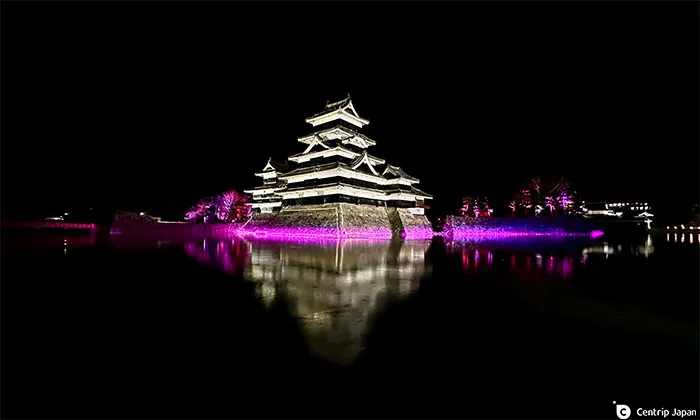 Projection mapping in winter
Projection mapping in winter
Popular in all seasons, Matsumoto Castle is especially beautiful during the cherry blossom season in spring, when the grounds are filled with blooming cherry trees against a backdrop of snow-covered, rugged mountains. In the winter, Matsumoto Castle's walls are used as a canvas for projection mapping.
From Nagoya to the west
Iga-Ueno Castle (Mie Prefecture)
There are many famous castles west of Nagoya. First, Iga City, famous as a ninja town, is a good place to start. Since it takes time to get to Iga City by train, it is convenient to rent a car or take the highway bus (Iga Ninja Liner) that leaves from Nagoya Station Bus Center.
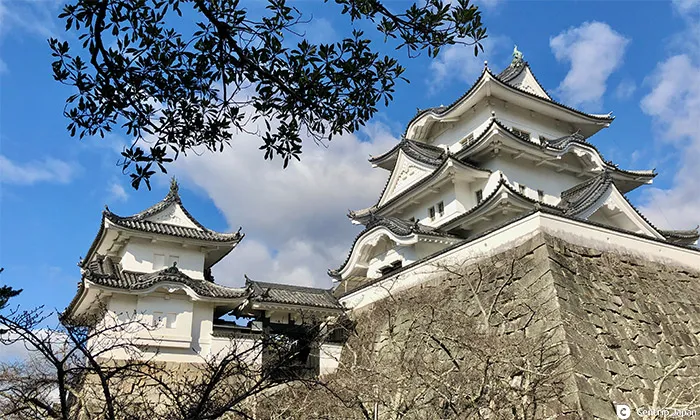 The beautiful white keep of Iga-Ueno Castle. The area around the castle tower is famous for its cherry blossoms.
The beautiful white keep of Iga-Ueno Castle. The area around the castle tower is famous for its cherry blossoms.
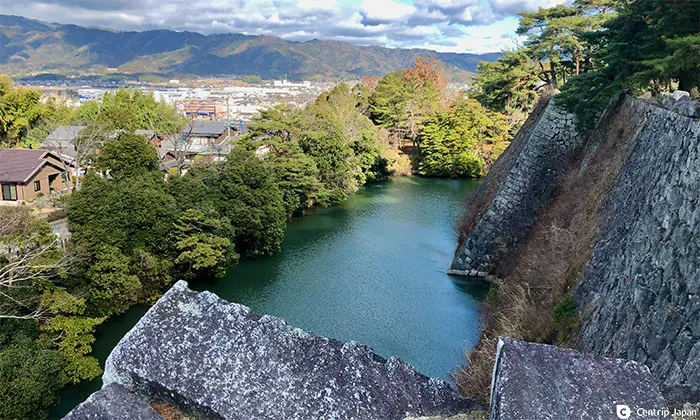 The 30-meter-high stone wall is considered the tallest in Japan. Be careful not to fall.
The 30-meter-high stone wall is considered the tallest in Japan. Be careful not to fall.
Iga-Ueno Castle was built by Takatora Todo, a feudal warlord considered a master castle builder. One of the highlights of the castle, along with Osaka Castle, is its stone walls, which are said to be the highest in Japan. The stone walls were also used as a filming location for the movie Kagemusha directed by Akira Kurosawa. The Iga Ninja Museum, the center of ninja tourism, is also located on the grounds of Iga Ueno Castle. It is a must-see destination in conjunction with a tour of the ninja villages of Iga and Koga.
The National Treasure Hikone Castle (Shiga Prefecture)
Hikone Castle, a national treasure, stands on the shore of Lake Biwa, the largest lake in Japan. It is close to Nagoya, and it takes about 35 minutes to reach Hikone Station, the nearest station by public transportation, by taking the Tokaido Shinkansen bullet train and a local train (about an hour by car from Koga City, the home of the ninja).
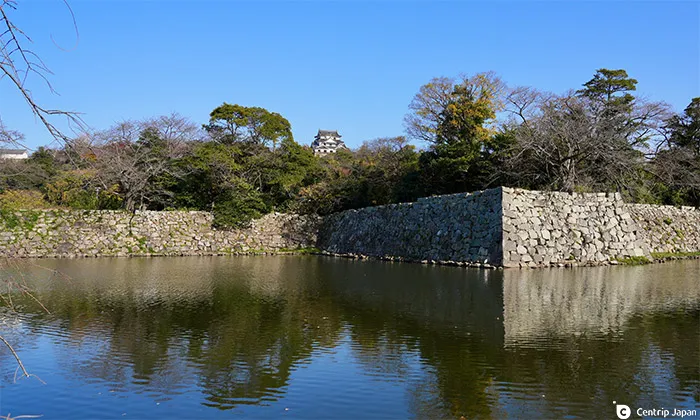 Hikone Castle keep seen from the outer moat
Hikone Castle keep seen from the outer moat
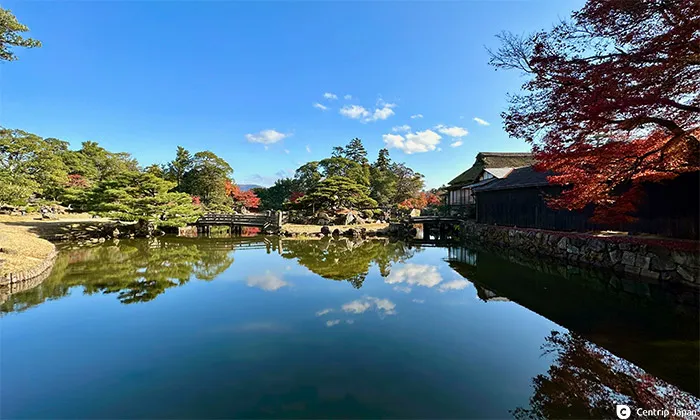 Genkyuen Garden, a famous scenic spot
Genkyuen Garden, a famous scenic spot
Hikone Castle has a wide variety of features, including the castle keep which is one of the 12 remaining keeps in Japan and a national treasure, the uniquely shaped taiko-mon tower, and the moat that surrounds it. The moat is filled with water from Lake Biwa, and houseboats operate regularly. It is a great way to experience the atmosphere of the castle from a different perspective. Hikone Castle's mascot Hikonyan is very popular. The garden, Genkyuen, is also wonderful to visit.
From Nagoya to the east
Okazaki Castle (Okazaki City, Aichi Prefecture)
To the east of Nagoya, castles associated with Tokugawa Ieyasu, the architect of the Edo period (1603-1868), line the city. Tokugawa Ieyasu is the main character in NHK's 2023 historical drama "Dousuru Ieyasu," which is drawing much attention in Japan, and related tourist facilities are being renovated to coincide with the release of the drama.
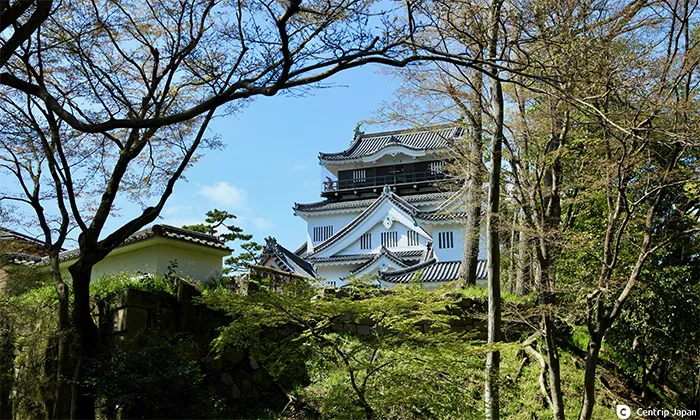 The keep of Okazaki Castle
The keep of Okazaki Castle
 Cherry blossom boat ride
Cherry blossom boat ride
Starting with Okazaki Castle, the birthplace of Tokugawa Ieyasu in 1543. The three-story keep, rebuilt in 1959, is the centerpiece of the park, renovated in January 2023, with exhibits utilizing the latest technology, including digital signage, to allow visitors to experience the atmosphere of the castle town and castle fortifications of the past. The area surrounding Okazaki Castle is also known as one of the best cherry blossom viewing spots in the Chubu area.
Hamamatsu Castle (Hamamatsu City, Shizuoka Prefecture)
The next castle, Hamamatsu Castle, is where Tokugawa Ieyasu moved his base of operations in 1570 to prepare for battle against his formidable enemy, the Takeda clan. The name Hamamatsu was also given by Ieyasu.
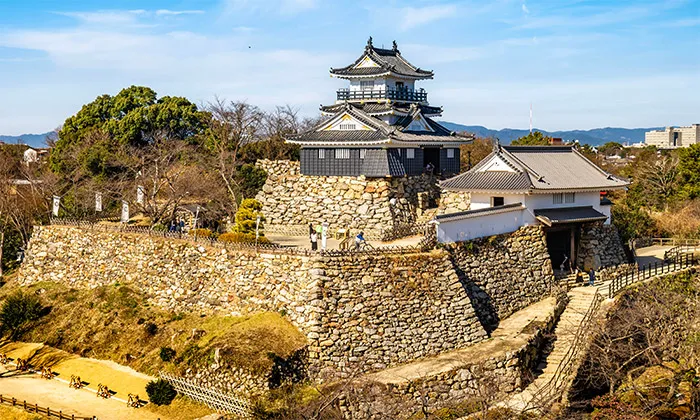 Hamamatsu Castle was built on the river terrace of the Tenryu River
Hamamatsu Castle was built on the river terrace of the Tenryu River
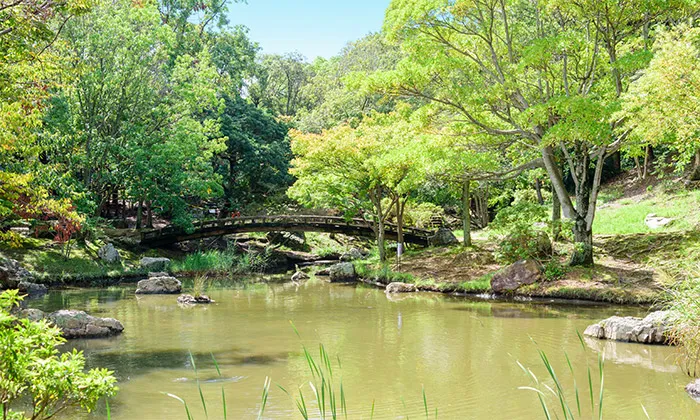 Japanese garden in Hamamatsu Castle Park
Japanese garden in Hamamatsu Castle Park
Ieyasu suffered a painful defeat at the hands of the Takeda clan here. It is said that Ieyasu, defeated, had a painter paint a portrait of himself as he looked immediately after his defeat in order to warn himself, and a three-dimensional reconstruction of his famous portrait Shikamizo is on display at Hamamatsu Castle. There are many other remains from the latter half of the 16th century, which were later developed in the Edo period (1603-1867), among other attractions in the area.
Sunpu Castle (Shizuoka City, Shizuoka Prefecture)
The last stop was Sunpu Castle in Shizuoka City. Ieyasu, who brought the Warring States period to a close and established the Edo Shogunate, moved his base of operations to Sunpu Castle after his early retirement from the shogunate in favor of his son, Hidetada. He spent the last 10 years of his life here, and his final days came in 1616.
 From the north gate of Sunpu Castle, visitors can take a small boat ride around the outer moat
From the north gate of Sunpu Castle, visitors can take a small boat ride around the outer moat
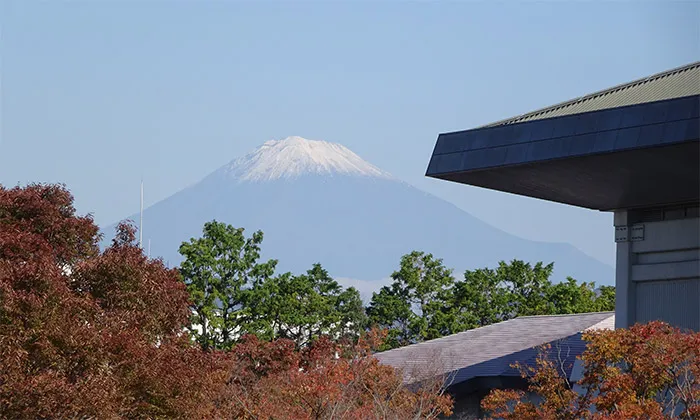 Mt. Fuji seen from Sunpu Castle Park
Mt. Fuji seen from Sunpu Castle Park
The area around Sunpu Castle was developed as Sunpu Castle Park, where the gate and the Ninomaru turret have been restored, and a bronze statue of Ieyasu in his later years was erected. On a clear day, the plaza inside the castle commands a magnificent view of Mt. Fuji, the very same Ieyasu viewed in his later years.
Wrap-up
Japanese castles may all look very similar, but each one has its own unique character, and attractions. By visiting several castles and comparing them with each other, you will discover the appeal of each one. We hope that by touring the Chubu area, the center of samurai culture, you will gain a deeper understanding of Japan's history and culture.

